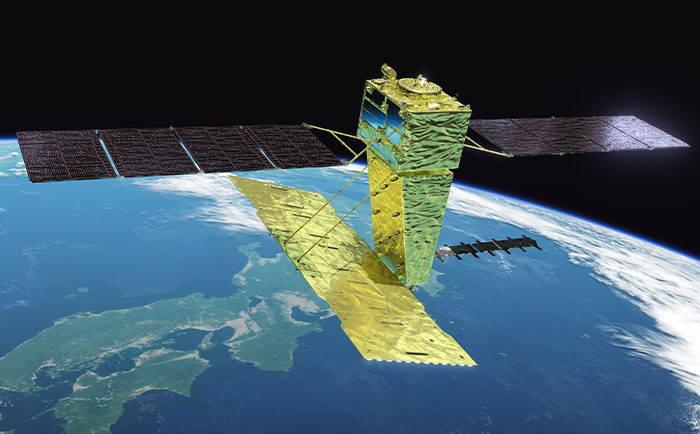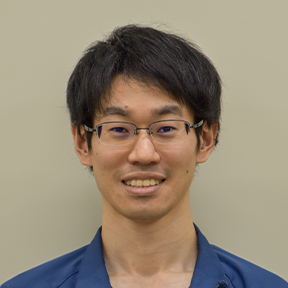2024.07.18

Mitsubishi Electric’s Incredible Advanced Land Observing Satellite-4 “DAICHI-4” (ALOS-4) to be Launched with a Mission to Detect Natural Disasters at an Early Stage

(C)JAXA
The Advanced Land Observing Satellite-4 (ALOS-4), also called “DAICHI-4,” jointly developed by Mitsubishi Electric Corporation and the Japan Aerospace Exploration Agency (JAXA) has been completed. ALOS-4 has a mass of approximately three tons and dimensions of 10m x 20m x 6.4m with its antennas fully deployed in orbit. Mitsubishi Electric Corporation began design and development of ALOS-4 in FY2016 with the aim of launching it in FY2024. The development project cost the company approximately 32 billion yen. We interviewed Masanobu Shibata and Yoichiro Kusuda, who were involved in the development of ALOS-4, about the technologies onboard, which have attracted worldwide attention, along with Mitsubishi Electric’s space business.
ALOS-4 measures changes in the Earth's surface to the centimeter! Observation is possible even at night and in bad weather
The mission of ALOS-4 is to detect early signs of natural disasters or quickly identify
damage in the event of a disaster. Shibata explains as follows:
”ALOS-4 is equipped with Synthetic Aperture Radar (SAR) as an observation instrument.
Generally, radar can increase its resolution by increasing the size of its antenna, but it
is physically difficult to install a large antenna on a satellite. To overcome this problem,
SAR is employed to virtually synthesize an antenna with a large aperture by repeatedly
transmitting and receiving electromagnetic waves while the satellite moves, generating
high-resolution images. Unlike optical sensors that require sunlight, SAR can perform
observations at night and even in bad weather since radio waves can pass through clouds and
rain. By observing the same location twice at different times, changes in the Earth's
surface can be measured to a high precision of several centimeters based on slight
deviations in the radio waves transmitted and received. SAR allows for early detection of
changes in volcanic activity and land subsidence from observation data on crustal
deformation and cracks in the ground. Comparing images before and after an earthquake,
typhoon, or other disaster can help grasp the severity of the damage,” said Shibata.
Compared to ALOS-2 launched in 2014, the swath width of ALOS-4 that can be observed at one
time is four times wider at 200 km wide, while maintaining high resolution. This improvement
was made possible by a new technology called digital beamforming (DBF), which is being used
for this application for the first time in the world. With conventional technology, only one
location at a time can be observed. However, the SAR “PALSAR-3” employing DBF technology
enables observation of up to four locations simultaneously by performing high-speed digital
computations in orbit. With the expanded swath width, ALOS-4 will increase the observation
frequency of the same location from four times per year with ALOS-2 to 20 times.
The amount of obtainable data from the satellite has increased due to the wider observation
swath, while the enhanced technology to transmit data to the ground has also achieved a
higher speed of about 3.6 Gbps, up from about 800 Mbps with ALOS-2.
Power generated by the solar cells has correspondingly increased from about 5,300 watts to
about 7,000 watts.
Repeated testing to ensure proper operation even in the harsh space environment
It took extraordinary effort to perfect ALOS-4, packed with state-of-the-art technologies.
The development team created a simulated space environment, characterized by factors such as
a vacuum and severe temperature changes. With a large airframe suspended, they repeated
their tests to confirm that each piece of equipment worked properly and met functional and
performance requirements.
”The SAR has a large antenna and emits very strong radio waves.
Particularly challenging was
EMI/EMC test in a radio-shielded environment to simulate the orbit condition with the test
setup of deployed SAR antenna under the gravity condition. RF interference of the test setup
was checked in cooperation with our Information Technology R&D Center,” said Kusuda.
”In developing the digital beamforming technology, we had to make adjustments to ensure
stable performance over a wide range of temperatures from -20°C to +55°C. We also had
considerable difficulty in correction processing to ensure that satisfactory images are
produced from observation data,” said Shibata.
The tests were conducted under a tight schedule. Despite its design life of five years,
ALOS-2 has been in operation for almost a decade.
The early launch of ALOS-4 is therefore
desired. Throughout the development, Kusuda and Shibata remained positive in the face of a
series of difficult challenges. ALOS-4 shares some bus components as ALOS-3. The
development of the new satellite progressed successfully with greater reliability and speed
by adopting a method to upgrade the equipment that had been developed for ALOS-3 instead of
developing it from scratch.
”We would like to see satellite data fully utilized by many people”
Kusuda joined the company in 2010 and was involved in satellite development until 2015,
followed by a one-year assignment in Singapore. After returning to Japan, he joined the
ALOS-4 development team. For Shibata, who joined the company in 2017 and has been in charge
of ALOS-4, the upcoming launch will be the first launch of a satellite that he has been
involved in.
”At a symposium in Southeast Asia, I saw students presenting their studies on various
topics, which incorporated data from ALOS-2 (some observation data is available through
JAXA’s satellite image data provision service). I hope that ALOS-4 will have a long service
life and that the data it generates will be used by many people around the world. I would
also like to see the launch of new businesses that use satellite data in the Mitsubishi
Group," said Kusuda.
”ALOS-4’s digital beamforming technology has attracted considerable attention from the
overseas academic community. Our company has the technological capability to compete
favorably with the rest of the world. We continue to hone our technological prowess and
project execution capabilities and promote them to the world. As an individual, I find it
rewarding to know that the products I have been involved with are contributing to the safety
and security of people not only in Japan but around the world as well. I would like to stay
involved in the development of satellites that will be useful going forward,” said Shibata.
Many employees at Mitsubishi Electric Corporation affectionately refer to the satellite by
its nickname. Their passion and expectations are embodied in ALOS-4.
”I am very pleased that the satellite we helped to develop is much loved both internally and
externally. I have high expectations for this launch,” said Kusuda.
INTERVIEWEES

YOICHIRO KUSUDA
Kamakura Works

MASANOBU SHIBATA
Kamakura Works
Mitsubishi Electric Corporation
Tokyo Building, 2-7-3, Marunouchi, Chiyoda-ku, Tokyo
Established in 1921. Upholding its Purpose to contribute to the realization of a vibrant and sustainable society through continuous technological innovation and ceaseless creativity, Mitsubishi Electric engages in the manufacture and sales of electric and electronic equipment used in energy and electric systems, industrial automation systems, information and communication systems, electronic devices, and home appliances. The company aims to transform itself into a Circular Digital-Engineering Company capable of providing advanced and integrated solutions through the fusion and co-creation of knowledge from within and outside the group, thereby addressing constantly diversifying social challenges.
